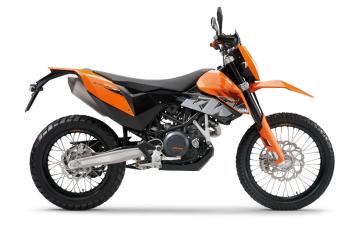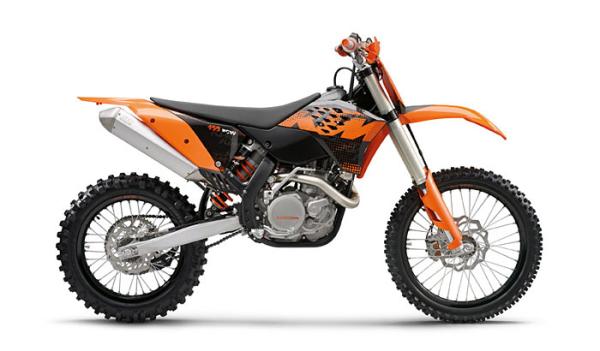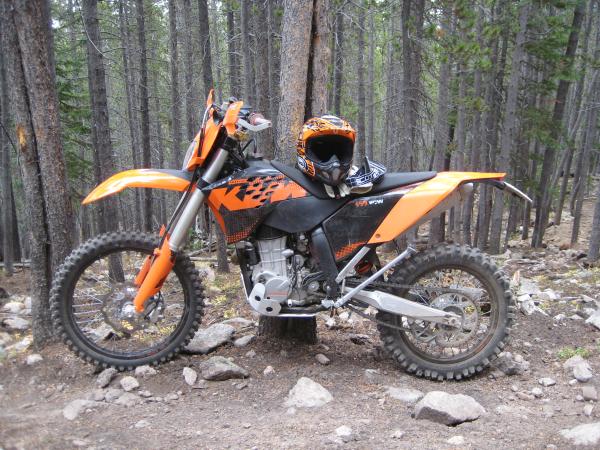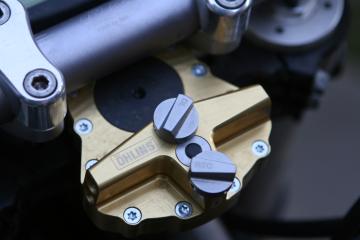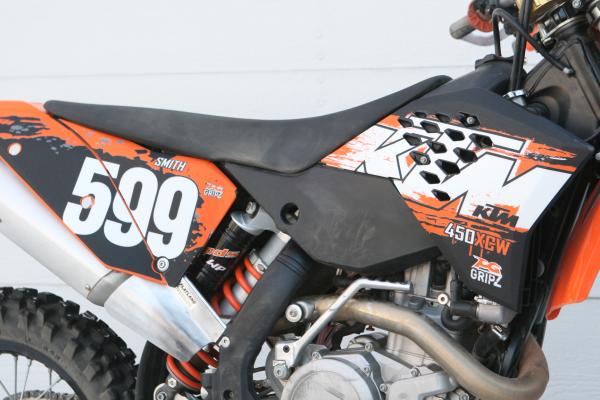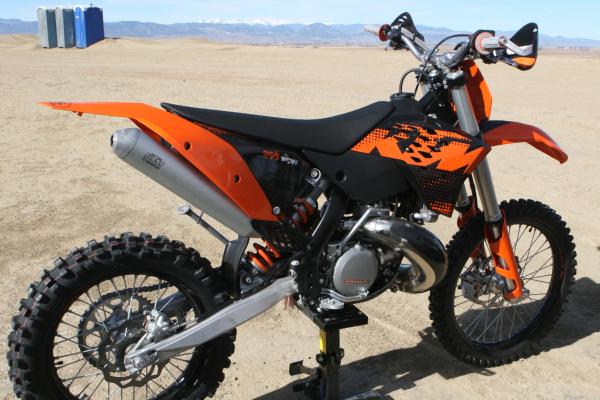I started looking at 650 cc class dual-sport bikes. The new fuel-injected KTM 690 Enduro and the BMW G650 X-Challenge both caught my eye. I mainly wanted something more fun, and I had no dirt-riding experience (other than riding a XR100 for two days at the American Supercamp in 2000).
I even looked at some of the factory supermoto bikes. They looked like a kick in the pants. But I wanted the ability to ride off-road, which ruled those out unless I wanted a second set of wheels. As I talked to my friends who have dirt bikes, they kept telling me that 650 was too big for trails, and a 450 was the best compromise for the range of trails and rides that we can do out here in Colorado.My other intense interest is competitive shooting. The types of events that I prefer are both technical and physical, with cross-country and endurance aspects. One thing I've learned is that there is no substitute for competition in terms of learning at an accelerated pace. Competition provides concrete and objective feedback, and there are always people who are faster or better to learn from. Enduros and hare-scramble races appealed to me.
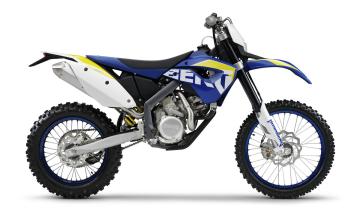
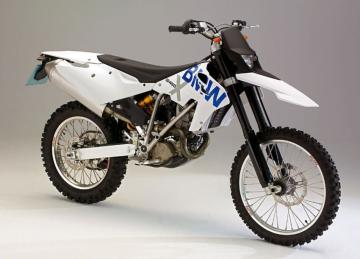
Both the '09 Husaberg FE450 and the BMW G450X incorporate radical new technology, which some have described as "game changers." Lack of local dealer support, aftermarket parts, and immediate delivery ruled them out for my first dirt-bike purchase.
This narrowed it down to the enduro/trail models in the 400-550 cc range, with a weight under about 260 lbs. KTM had the 400, 450, and 530 XC-W. Husqvarna had the TE450 and TE510. The new Husaberg FE450 and FE570 looked great, and pictures of the BMW G450X were just coming available. The Husqvarna had decent local dealer support, but significantly less aftermarket support and the gas tank was less than 2 gallons. The Husaberg looked awesome and had excellent reviews. It's probably the most advanced enduro 4-stroke bike out right now, and about the same price as the KTMs. For me, the Husaberg was ruled out because it wasn't quite available yet, and there were zero local dealers. Also, there is virtually no aftermarket support, and getting a larger tank would have been very difficult. The BMW was a non-starter because even the local dealers had no clue when it'd be available. There is an excellent local KTM dealer, Elite KTM, in Loveland Colorado. The guys there are very helpful, knowledgeable, and no-pressure.
Now that I had decided on the KTM, which model should I choose? KTM has a dizzying array of dirt bikes. They have the SX, SXF, XC, XCF, XCW, and EXC model lines, with displacements from 125 cc up to 530 cc. The SX series is for motocross- it's fast revving, sprung stuff, and has a close-ratio gearbox. One thing is clear: KTM is serious about off-road motorcycles and fills every niche in that market.
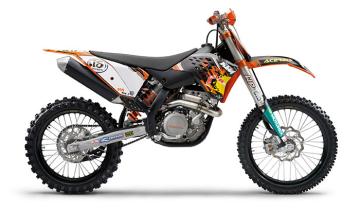
The only remaining question was what size engine to get, 400, 450, or 530. The 400's hadn't been delivered yet, so it was out. So, 450 or 530? Most people usually recommend the 450 because they are lighter and have less rotating mass. however, the 530 KTM weighs the same as the 450, and the new '08 and '09 engines had even less rotating mass than the '07 RFS motors. In the end, I figured it didn't matte too much, and the 450 would more likely be better on tighter trails than the 530. I walked into Elite KTM in the mid afternoon, told Don I wanted an '09 450 XCW with the street kit, and it was "so." The paperwork was quick and painless, and by 5 pm, Roger had delivered the bike to my garage in Fort Collins.
At first, simply the seat height of the dirt bikes was really intimidating. Coming from street bikes, a big deal is always made about having a low seat height and being able to touch the ground with both feet, or even flat-foot the bike. My inseam is about 30 inches and there are relatively few bikes I can flat-foot with both feet.
The 38 inch seat height quoted on the KTMs seemed totally crazy, but I basically just manned up and figured I'd deal with it. First, one thing to realize is that the bike sags when you sit on it, and secondly, the suspension will break in and then it will sag a little easier. However, I think most people really over-emphasize the need for a short seat height. With a light 250 lb bike, it's no problem to just be able to touch the ground with one foot (or toe), and you can lean it over a little bit more without the danger of it tipping over like a 500 lb street bike. Off-road, I hardly ever noticed the high seat height, partly because there are often rocks or logs to rest a leg on. The suspension is critically important to off-road handling and being higher above obstacles leaves more suspension travel to soak up hits.For the first month, the KTM blew my mind every ride on new terrain in terms of what it could handle. Obstacles which I thought there was no way in hell I could make it over, the KTM would just float over if I could keep the bike moving and upright. When I was in high-school and college, I road a lot on my hard-tail mountain bike and when I was a kid, I raced BMX. I had some idea what a two-wheeled vehicle could do, but a modern dirt-bike is totally amazing and blows what I could ever do on a mountain bike out of the water.

The hare scramble course at VDR in Berthoud Colorado uses the motocross track as part of the course. I've also ridden the MX track quite a bit for practice. The KTM 450 XCW is soft sprung which shows up on the jumps, but other than that it handles pretty well. It's important I set up corners properly so the suspension isn't working against me. I think the other dedicated MX bikes make more power, but I'm not wringing out the XCW motor either. Since even little 125 two-strokes motor by me from time to time, I know that I am still the slow part of the package.
All in all I am very pleased with the KTM 450 XCW. The motor has more than enough power, but not so much that I lose traction all the time. The suspension is amazing and will float over most obstacles. The bike is not very tighly focussed like a motorcross bike or two-stroke pure trail bike-- it seems to do it all well and it's a pure dirt machine. Those guys at KTM know how to make a dirt bike.
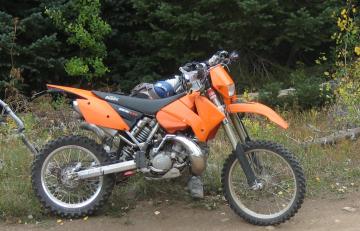
Adventure - Rally: 600-700cc big singles with large fuel capacity and more high-speed and
long-range ability at the expense of tight trail maneuverability and weight. The KTM 690 Enduro,
BMW G650 X-Challenge, KLR 650, and XR650 and their respective "Rally" versions fit this use. A
Husaberg 570 or KTM 530 might fit in this category with a well-integrated Rally kit.
Motorcross Racing: These bikes make great power and have suspension set up ideally for motocross tracks. They are usually four-strokes for power delivery. While a 450 would seem redundant, a 250 - 450 MX bike would handle a lot better on track.
Lightweight Trail: This is code for lightweight two-stroke, such as the KTM 200/250/300 XC.
I like the idea of having a dedicated race bike, so a smaller 250-400 cc KTM SX, SXF, XC, or XCF might fit the bill. If Husaberg comes out with a FE390 in 2010, that might be a good choice.
Yes, I picked up a new 09 250 XCW, the 250-cc two-stroke intended for enduro/cross-country use. The engine is mildly tuned for best control, traction, and drive-ability. I'll write more about the 250 in future articles.


